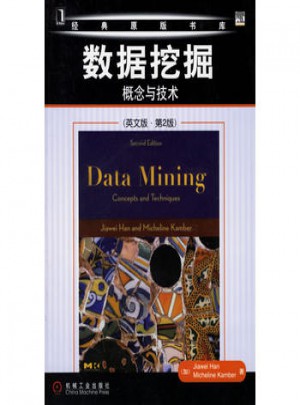

我们产生和收集数据的能力正在快速增长。除了大多数商业、科学和政府事务的日益计算机化会产生数据之外,数码相机、工具和条码的广泛应用也会产生数据。在数据收集方面,扫描的文体和图像平台、卫星遥感系统和国际互联网已经使我们的生活被巨大的数据量所包围。这种爆炸性的数据增长促使我们比以往更迫切地需要新技术和自动化工具来帮助我们将这些数据转换为有用的信息和知识。
本书第1版曾被KDnuggets的读者评选为受欢迎的数据挖掘专著,是一本可读性极佳的教材。它从数据库角度系统地介绍了数据挖掘的基本概念、基本方法和基本技术以及数据挖掘的技术研究进展,重点关注其可行性、有用性、有效性和可伸缩性问题。但是,自第1版出版之后,数据挖掘领域的研究又取得了很大的进展,开发出了新的数据挖掘方法、系统和应用。第2版在这一方面进行了加强,增加了多个章节讲述的数据挖掘方法,以便能够挖掘出复杂类型的数据,包括流数据、序列数据、图结构数据、社群网络数据和多重关系数据。
本书适合作为高等院校计算及相关专业高年级本科生的选修课教材,特别适合作为研究生的专业课教材,同时也可供从事数数据挖掘研究和应用开发工作的相关人员作为必备的参考书。
本书主要特点是:实用地论述了从实际业务数据中抽取出的读者需要知道的概念和技术。更新并结合了来自读者的反馈、数据挖掘领域的技术变化以及统计和机器学习方面的更多资料。包含了许多算法和实际示例,全部以易于理解的伪代码编写,适用于实际的大规模数据挖掘项目。
韩家炜,伊利诺伊大学厄巴纳一尚佩恩分校计算机科学系教授。由于在数据挖掘和数据库系统领域卓有成效的研究工作,他曾多次获得各种荣誉和奖励,其中包括2004年ACM SIGKDD颁发的创新奖。同时,他还是《ACM Trarlsactiorls on Krlowledge Discovery fronl Data》杂志的主编,以
Foreword vii
Preface ix
Chapter1 Introduction
1.1 What Motivated Data Mining? Why Is It Important?
1.2 So, What Is Data Mining?
1.3 Data Mining-On What Kind of Data?
1.3.1 Relational Databases
1.3.2 Data Warehouses
1.3.3 TransactionalDatabases
1.3.4 Advanced Data and Information Systems and Advanced Applications
1.4 Data Mining Functionalities---What Kinds of Patterns Can Be Mined?
1.4.1 Concept/Class Description: Characterization and Discrimination
1.4.2 Mining Frequent Patterns, Associations, and Correlations
1.4.3 Classification and Prediction 24 1.4.4 Cluster Analysis
1.4.5 Outlier Analysis 26 1.4.6 Evolution Analysis
1.5 Are All of the Patterns Interesting?
1.6 Classification of Data Mining Systems
1.7 Data Mining Task Primitives
1.8 Integration of a Data Mining System with a Database or Data Warehouse System
1.9 Major Issues in Data Mining
1.10 Summary
Exercises
Bibliographic Notes
Chapter2 Data Preprocessing
2.1 Why Preprocess the Data?
2.2 Descriptive Data Summarization
2.2.1 Measuring the Central Tendency
2.2.2 Measuring the Dispersion of Data
2.2.3 Graphic Displays of Basic Descriptive Data Summaries
2.3 Data Cleaning
2.3.1 Missing Values
2.3.2 Noisy Data
2.3.3 Data Cleaning as a Process
2.4 Data Integration and Transformation
2.4.1 Data Integration
2.4.2 Data Transformation
2.5 Data Reduction
2.5.1 Data Cube Aggregation
2.5.2 Attribute Subset Selection
2.5.3 DimensionalityReduction
2.5.4 Numerosity Reduction
2.6 Data Discretization and Concept Hierarchy Generation
2.6.1 Discretization and Concept Hierarchy Generation for Numerical Data
2.6.2 Concept Hierarchy Generation for Categorical Data
2.7 Summary 97 Exercises 97 Bibliographic Notes
Chapter3 Data Warehouse and OLAP Technology: An Overview
3.1 What Is a Data Warehouse?
3.1.1 Differences between Operational Database Systems and Data Warehouses
3.1.2 But, Why Have a Separate Data Warehouse?
3.2 A Multidimensional Data Model
3.2.1 From Tables and Spreadsheets to Data Cubes
3.2.2 Stars, Snowflakes, and Fact Constellations: Schemas for Multidimensional Databases
3.2.3 Examples for Defining Star, Snowflake, and Fact Constellation Schemas
……
Chapter4 Data Cube Computation and Data Generalization
Chapter5 Mining Frequent Patterns, Associations, and Correlations
Chapter6 Classification adn Predidction
Chapter7 Cluster Analysis
Chapter8 Mining Stream, Time-Series, and Sepuence Data
Chapter9 Graph Mining, Social Network Analysis, and Multirelational
Chapter10 Mining Object, Spatial, Multimedia, Test, and Wed Data
Chapter11 Applications and Trends in Data Mining
An Introduction to Microsoft's OLE DB for
Bibliography
Index